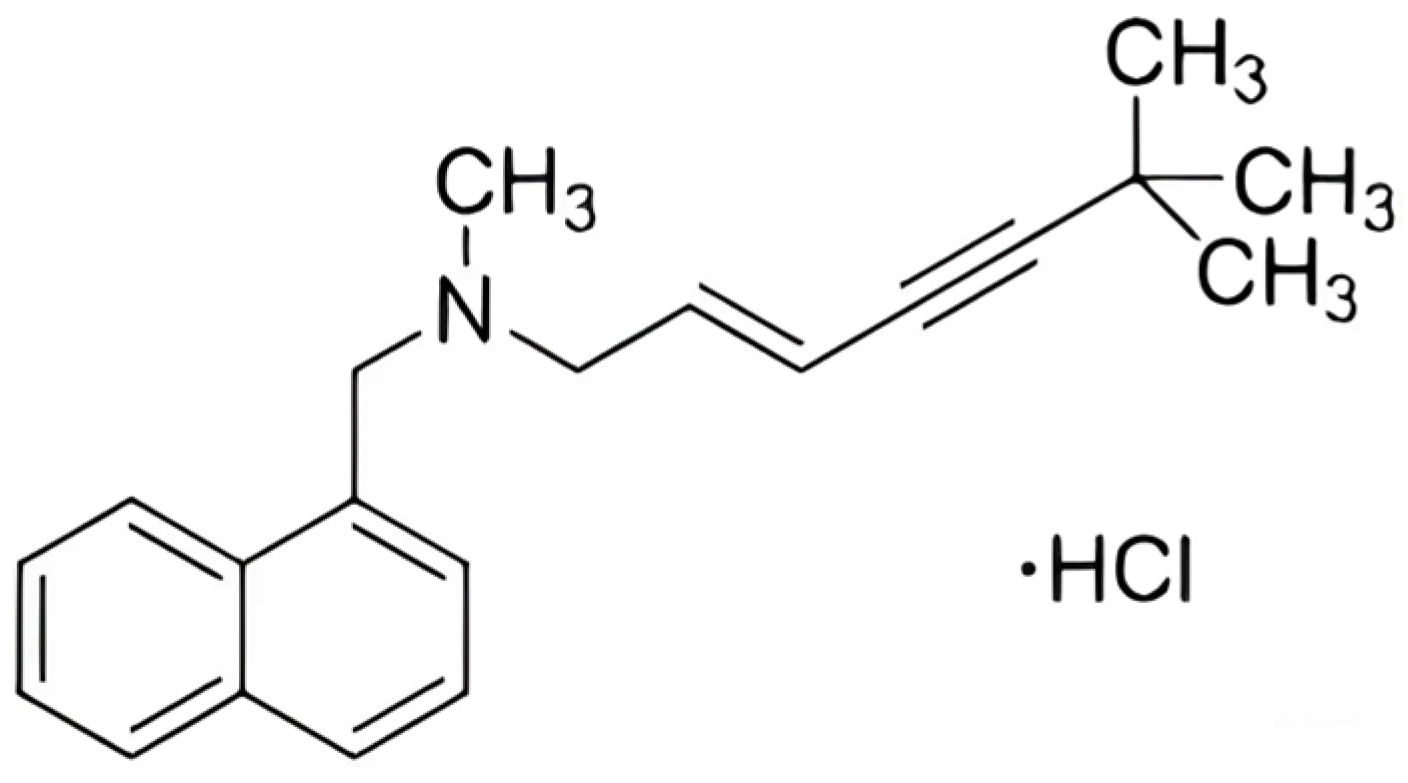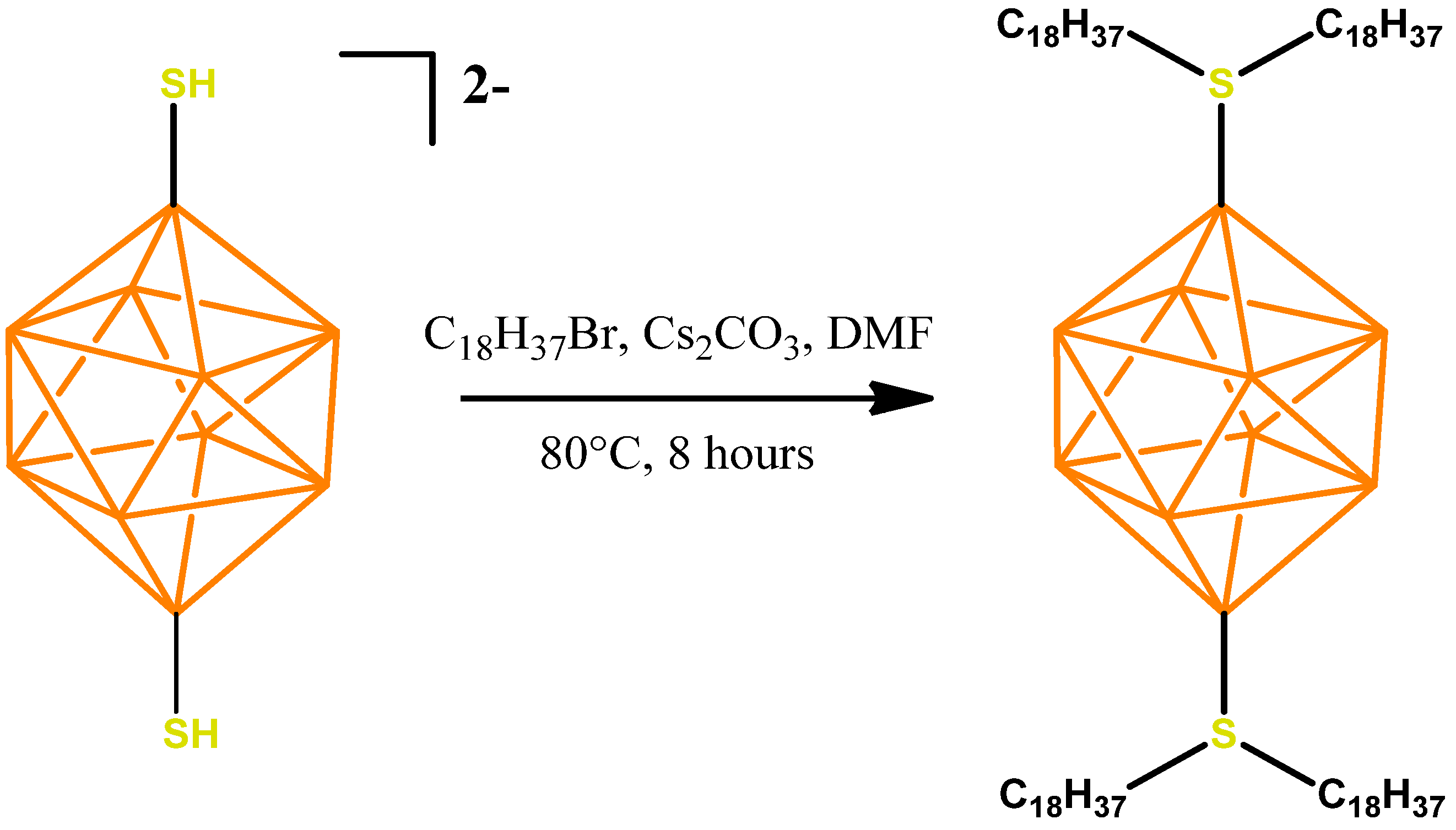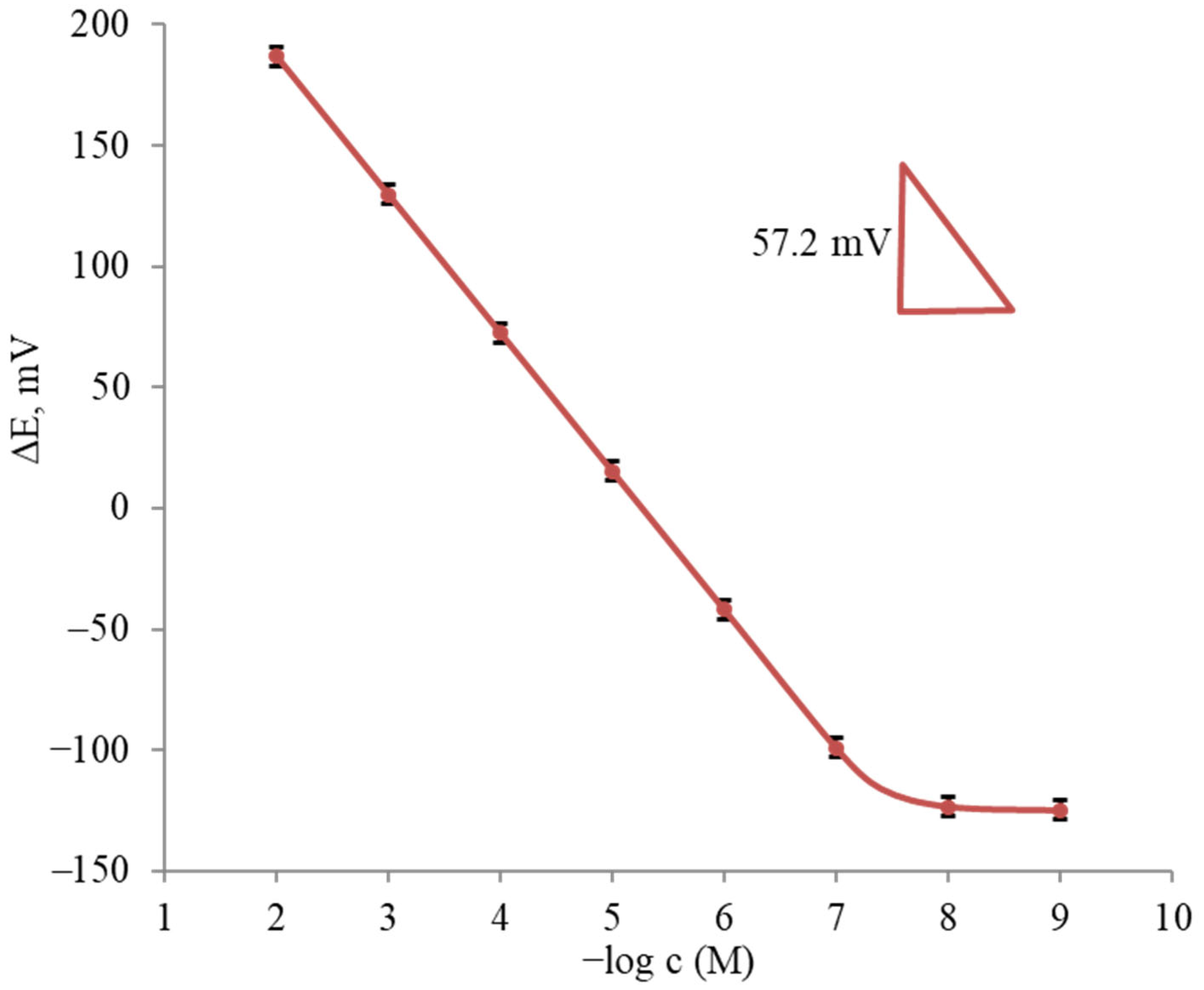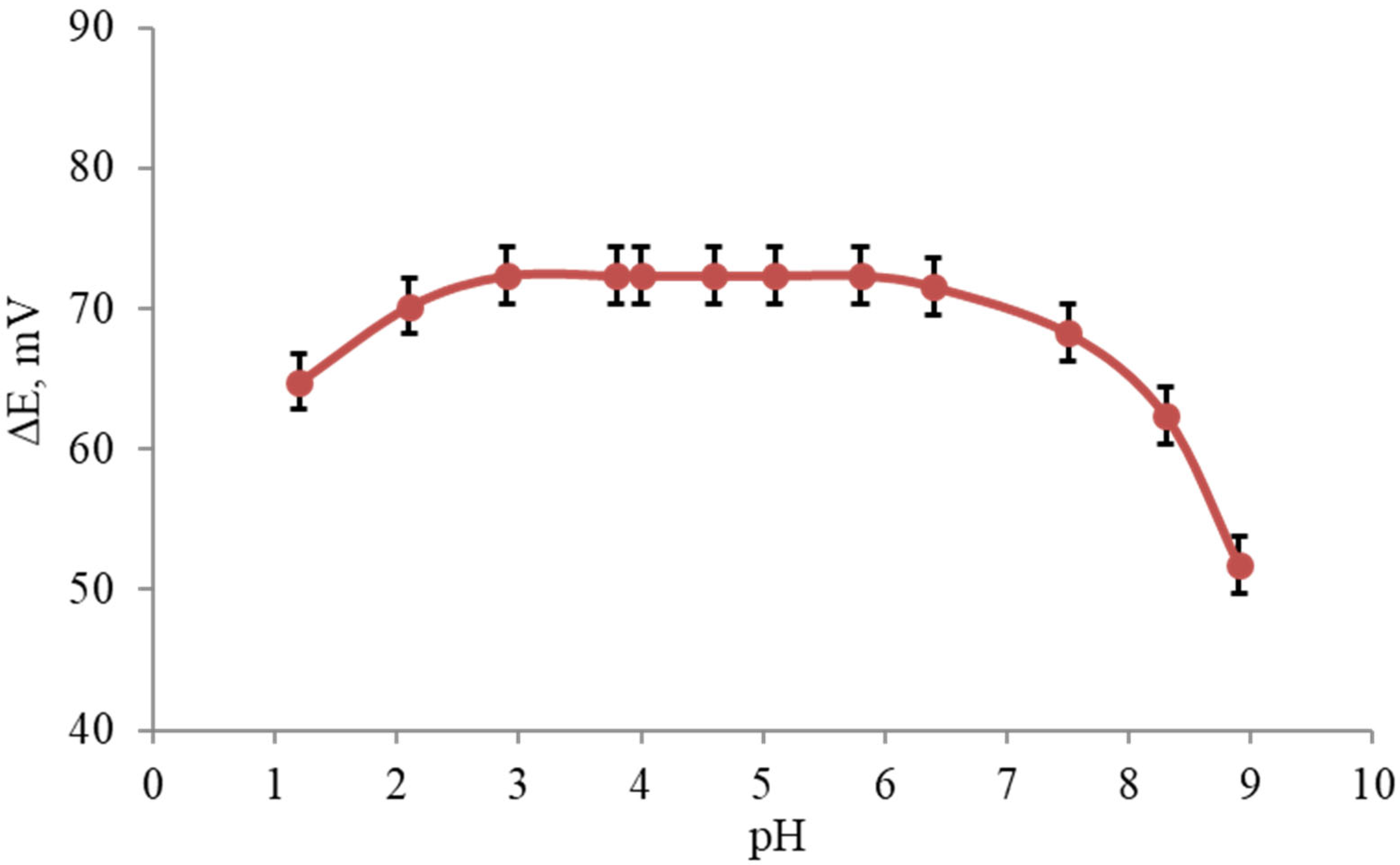Preparation of a New Active Component 1,10-B10H8(S(C18H37)2)2 for Potentiometric Membranes for the Determination of Terbinafine Hydrochloride
Abstract
1. Introduction
2. Results
2.1. Synthesis of the Active Ingredient
2.2. Ion Sensor Development
3. Materials and Methods
3.1. Analyses and Reagents
3.2. Synthesis of 1,10-B10H8(S(n-C18H37)2)2
3.3. Manufacturing Membranes
3.4. Potentiometric Measurements
| Ag/AgCl | 1.0 mM terbinafine hydrochloride | PVC membrane | Sample solution | AgClsatd, 3M KCl | AgCl/Ag |
4. Conclusions
Supplementary Materials
Author Contributions
Funding
Institutional Review Board Statement
Data Availability Statement
Acknowledgments
Conflicts of Interest
References
- Available online: https://www.un.org/ru/global-issues/water (accessed on 23 January 2025).
- Agnew, C.; Anderson, E. Water Resources in the Arid Realm; Routledge: London, UK, 2024; ISBN 9781003463917. [Google Scholar]
- Abramova, I.O. The Population of Africa under the Conditions of Transformation of the World Order. Her. Russ. Acad. Sci. 2022, 92, S1306–S1315. [Google Scholar] [CrossRef]
- Abramova, I.O.; Sharova, A.Y. Geostrategic Risks in the Transition to Green Energies (Using the Example of Africa). Geol. Ore Depos. 2023, 65, 449–462. [Google Scholar] [CrossRef]
- Yan, X.; Xia, Y.; Ti, C.; Shan, J.; Wu, Y.; Yan, X. Thirty Years of Experience in Water Pollution Control in Taihu Lake: A Review. Sci. Total Environ. 2024, 914, 169821. [Google Scholar] [CrossRef] [PubMed]
- Qin, B.; Zhang, Y.; Zhu, G.; Gao, G. Eutrophication Control of Large Shallow Lakes in China. Sci. Total Environ. 2023, 881, 163494. [Google Scholar] [CrossRef]
- Yu, S.; Du, X.; Lei, Q.; Wang, X.; Wu, S.; Liu, H. Long-Term Variations of Water Quality and Nutrient Load Inputs in a Large Shallow Lake of Yellow River Basin: Implications for Lake Water Quality Improvements. Sci. Total Environ. 2023, 900, 165776. [Google Scholar] [CrossRef]
- Zdrachek, E.; Bakker, E. Potentiometric Sensing. Anal. Chem. 2021, 93, 72–102. [Google Scholar] [CrossRef]
- Cuartero, M.; Colozza, N.; Fernández-Pérez, B.M.; Crespo, G.A. Why Ammonium Detection Is Particularly Challenging but Insightful with Ionophore-Based Potentiometric Sensors—An Overview of the Progress in the Last 20 Years. Analyst 2020, 145, 3188–3210. [Google Scholar] [CrossRef]
- Ding, J.; Qin, W. Recent Advances in Potentiometric Biosensors. TrAC Trends Anal. Chem. 2020, 124, 115803. [Google Scholar] [CrossRef]
- Gil, R.L.; Amorim, C.G.; Montenegro, M.C.B.S.M.; Araújo, A.N. HPLC-Potentiometric Method for Determination of Biogenic Amines in Alcoholic Beverages: A Reliable Approach for Food Quality Control. Food Chem. 2022, 372, 131288. [Google Scholar] [CrossRef]
- Turyshev, E.S.; Kopytin, A.V.; Zhizhin, K.Y.; Kubasov, A.S.; Shpigun, L.K.; Kuznetsov, N.T. Potentiometric Quantitation of General Local Anesthetics with a New Highly Sensitive Membrane Sensor. Talanta 2022, 241, 123239. [Google Scholar] [CrossRef]
- Turyshev, E.S.; Kubasov, A.S.; Golubev, A.V.; Zhizhin, K.Y.; Kuznetsov, N.T. Potentiometric Method for Determining Biologically Non-Degradable Antimicrobial Substances. Russ. J. Inorg. Chem. 2023, 68, 1841–1847. [Google Scholar] [CrossRef]
- Stuetz, A.; Petranyi, G. Synthesis and Antifungal Activity of (E)-N-(6,6-Dimethyl-2-Hepten-4-Ynyl)-N-Methyl-1-Naphthalenemethanamine (SF 86-327) and Related Allylamine Derivatives with Enhanced Oral Activity. J. Med. Chem. 1984, 27, 1539–1543. [Google Scholar] [CrossRef] [PubMed]
- Goodfield, M.J.D.; Rowell, N.R.; Forster, R.A.; Evans, E.G.V.; Raven, A. Treatment of Dermatophyte Infection of the Finger- and Toe-Nails with Terbinafine (SF 86-327, Lamisil), an Orally Active Fungicidal Agent. Br. J. Dermatol. 1989, 121, 753–757. [Google Scholar] [CrossRef]
- Petranyi, G.; Ryder, N.S.; Stütz, A. Allylamine Derivatives: New Class of Synthetic Antifungal Agents Inhibiting Fungal Squalene Epoxidase. Science (1979) 1984, 224, 1239–1241. [Google Scholar] [CrossRef]
- Ryder, N.S. Specific Inhibition of Fungal Sterol Biosynthesis by SF 86-327, a New Allylamine Antimycotic Agent. Antimicrob. Agents Chemother. 1985, 27, 252–256. [Google Scholar] [CrossRef]
- Joly-Tonetti, N.; Legouffe, R.; Tomezyk, A.; Gumez, C.; Gaudin, M.; Bonnel, D.; Schaller, M. Penetration Profile of Terbinafine Compared to Amorolfine in Mycotic Human Toenails Quantified by Matrix-Assisted Laser Desorption Ionization–Fourier Transform Ion Cyclotron Resonance Imaging. Infect. Dis. Ther. 2024, 13, 1281–1290. [Google Scholar] [CrossRef]
- Nakamura, T.; Yoshinouchi, T.; Okumura, M.; Yokoyama, T.; Mori, D.; Nakata, H.; Yasunaga, J.; Tanaka, Y. Antifungal Potency of Terbinafine as a Therapeutic Agent against Exophiala Dermatitidis in Vitro. bioRxiv 2024. [Google Scholar] [CrossRef]
- Viana, P.G.; Figueiredo, A.B.F.; Gremião, I.D.F.; de Miranda, L.H.M.; da Silva Antonio, I.M.; Boechat, J.S.; de Sá Machado, A.C.; de Oliveira, M.M.E.; Pereira, S.A. Successful Treatment of Canine Sporotrichosis with Terbinafine: Case Reports and Literature Review. Mycopathologia 2018, 183, 471–478. [Google Scholar] [CrossRef]
- Pinto, Â.V.; Oliveira, J.C.; Costa de Medeiros, C.A.; Silva, S.L.; Pereira, F.O. Potentiation of Antifungal Activity of Terbinafine by Dihydrojasmone and Terpinolene against Dermatophytes. Lett. Appl. Microbiol. 2021, 72, 292–298. [Google Scholar] [CrossRef]
- Li, M.; Chen, X.; Su, X.; Gao, W. The Preparation and Evaluation of a Hydrochloride Hydrogel Patch with an Iontophoresis-Assisted Release of Terbinafine for Transdermal Delivery. Gels 2024, 10, 456. [Google Scholar] [CrossRef]
- Cox, S.; Hayes, J.; Hamill, M.; Martin, A.; Pistole, N.; Yarbrough, J.; Souza, M. Determining Terbinafine in Plasma and Saline Using HPLC. J. Liq. Chromatogr. Relat. Technol. 2015, 38, 607–612. [Google Scholar] [CrossRef]
- Matysová, L.; Solich, P.; Marek, P.; Havlíková, L.; Nováková, L.; Šícha, J. Separation and Determination of Terbinafine and Its Four Impurities of Similar Structure Using Simple RP-HPLC Method. Talanta 2006, 68, 713–720. [Google Scholar] [CrossRef] [PubMed]
- Separovic, L.; Lourenço, F.R. Measurement Uncertainty Evaluation of an Analytical Procedure for Determination of Terbinafine Hydrochloride in Creams by HPLC and Optimization Strategies Using Analytical Quality by Design. Microchem. J. 2022, 178, 107386. [Google Scholar] [CrossRef]
- Gund, A.; Datar, P.A.; Kunjir, V.V. Analytical method development and validation of an allylamine antifungal drug, Terbinafine hydrochloride: A review. Int. J. Nov. Res. Dev. 2024, 9, a788–a815. [Google Scholar]
- Faridbod, F.; Ganjali, M.R.; Norouzi, P. Potentiometric PVC Membrane Sensor for the Determination of Terbinafine. Int. J. Electrochem. Sci. 2013, 8, 6107–6117. [Google Scholar] [CrossRef]
- El-Beshlawy, M.; Arida, H. Modified Screen-Printed Microchip for Potentiometric Detection of Terbinafine Drugs. J. Chem. 2022, 2022, 1–8. [Google Scholar] [CrossRef]
- El-Rahman, M.K.A.; Sayed, R.A.; El-Masry, M.S.; Hassan, W.S.; Shalaby, A. Development of Potentiometric Method for In Situ Testing of Terbinafine HCl Dissolution Behavior Using Liquid Inner Contact Ion-Selective Electrode Membrane. J. Electrochem. Soc. 2018, 165, B143–B149. [Google Scholar] [CrossRef]
- Kubasov, A.S.; Turishev, E.S.; Kopytin, A.V.; Shpigun, L.K.; Zhizhin, K.Y.; Kuznetsov, N.T. Sulfonium Closo-Hydridodecaborate Anions as Active Components of a Potentiometric Membrane Sensor for Lidocaine Hydrochloride. Inorganica Chim. Acta 2021, 514, 119992. [Google Scholar] [CrossRef]
- Alterary, S.S.; Mostafa, G.A.E.; El-Tohamy, M.F.; Elhadi, A.M.; AlRabiah, H. A Novel Potentiometric Coated Wire Sensor Based on Functionalized Polymeric CaO/ZnO Nanocomposite Synthesized by Lavandula Spica Mediated Extract for Terbinafine Determination. ChemistrySelect 2024, 9, e202401217. [Google Scholar] [CrossRef]
- Kubasov, A.S.; Turishev, E.S.; Polyakova, I.N.; Matveev, E.Y.; Zhizhin, K.Y.; Kuznetsov, N.T. The Method for Synthesis of 2-Sulfanyl Closo-Decaborate Anion and Its S-Alkyl and S-Acyl Derivatives. J. Organomet. Chem. 2017, 828, 106–115. [Google Scholar] [CrossRef]
- Golubev, A.V.; Baltovskaya, D.V.; Kubasov, A.S.; Bykov, A.Y.; Zhizhin, K.Y.; Kuznetsov, N.T. Synthesis of 1,10-Disulfanyl-Closo-Decaborate Anion and Its Disulfonium Tetraacetylamide Derivative. Russ. J. Inorg. Chem. 2024, 1–10. [Google Scholar] [CrossRef]
- Freiser, H. (Ed.) Ion-Selective Electrodes in Analytical Chemistry; Springer: Boston, MA, USA, 1978; ISBN 978-1-4684-2594-9. [Google Scholar]
- Bobacka, J.; Ivaska, A.; Lewenstam, A. Potentiometric Ion Sensors. Chem. Rev. 2008, 108, 329–351. [Google Scholar] [CrossRef]
- Gordon, J. Organic Chemistry of Electrolytes Solutions; Mir: Moscow, Russia, 1979. [Google Scholar]
- Buck, R.P.; Lindner, E. Recommendations for Nomenclature of Ionselective Electrodes (IUPAC Recommendations 1994). Pure Appl. Chem. 1994, 66, 2527–2536. [Google Scholar] [CrossRef]
- Gadzekpo, V.P.Y.; Christian, G.D. Determination of Selectivity Coefficients of Ion-Selective Electrodes by a Matched-Potential Method. Anal. Chim. Acta 1984, 164, 279–282. [Google Scholar] [CrossRef]
- Morf, W.E.; Lindner, E.; Simon, W. Theoretical Treatment of the Dynamic Response of Ion-Selective Membrane Electrodes. Anal. Chem. 1975, 47, 1596–1601. [Google Scholar] [CrossRef]




| Active Membrane Ingredient | Linear Range, M | LOD, M | References |
|---|---|---|---|
| Terbinafine screen-printed microchip modified with MWCNTs | 1.0 × 10−2–1.0 × 10−8 | 5.0 × 10−9 | [28] |
| Ion-pair terbinafine and tetraphenyl borate functionalized CaO/ZnO | 1.0 × 10−2–7.0 × 10−6 | 6.5 × 10−6 | [27] |
| Sodium tetraphenylborate | 1.0 × 10−2–1.0 × 10−6 | 7.9 × 10−7 | [29] |
| Ion-pair terbinafine and tetraphenyl borate functionalized CaO/ZnO | 1.0 × 10−2–5.0 × 10−9 | 2.5 × 10−10 | [31] |
| № | Membrane Composition, % wt | Linear Range, M | Lower Detection Limit, M | Slope, mV/Decade | ||
|---|---|---|---|---|---|---|
| 1,10-B10H8(S(n-C18H37)2)2 | BBPA | PVC | ||||
| 1 | 1.0 | 70.0 | 29.0 | ≈10−8–10−2 | ≈5.0 × 10−9 | 60 ± 2 |
| 2 | 1.2 | 69.8 | 29.0 | ≈10−8–10−2 | ≈6.0 × 10−9 | 59 ± 1 |
| 3 | 1.4 | 69.6 | 29.0 | ≈2.0 × 10−8–10−2 | ≈7.0 × 10−9 | 58.2 ± 0.5 |
| 4 | 1.6 | 69.4 | 29.0 | ≈3.0 × 10−8–10−2 | ≈8.0 × 10−9 | 57.7 ± 0.3 |
| 5 | 1.8 | 69.2 | 29.0 | 4.0 × 10−8–10−2 | 1.0 × 10−8 | 57.2 ± 0.2 |
| 6 | 2.0 | 69.0 | 29.0 | 8.0 × 10−8–10−2 | 3.0 × 10−8 | 55.9 ± 0.2 |
| 7 | 2.2 | 68.8 | 29.0 | 10−7–10−2 | 5.0 × 10−8 | 53.6 ± 0.2 |
| 8 | 2.4 | 68.6 | 29.0 | 3.0 × 10−7–10−2 | 7.0 × 10−8 | 52.3 ± 0.2 |
| Interfering Cation | lgKpot Terbinafine/Cation | ||
|---|---|---|---|
| MPM | Middle | SSM | |
| Li+ | −3.41 | −4.12 | −4.83 |
| Na+ | −3.37 | −3.85 | −4.33 |
| K+ | −3.80 | −3.91 | −4.02 |
| Rb+ | −3.16 | −3.96 | −4.76 |
| Cs+ | −3.63 | −4.18 | −4.73 |
| Ca2+ | −4.03 | −4.64 | −5.25 |
| Sr2+ | −4.17 | −4.73 | −5.29 |
| Ba2+ | −4.45 | −5.02 | −5.59 |
| NH4+ | −2.52 | −3.29 | −4.06 |
| Glycine | −3.32 | −3.72 | −4.12 |
| Valine | −3.42 | −3.68 | −3.94 |
| β-Alanine | −3.25 | −3.52 | −3.79 |
| L, D-Tyrosine | −3.01 | −3.21 | −3.41 |
| Tetrabutylammonium+ (TBA+) | −2.32 | −3.01 | −3.70 |
| Glucose | −4.56 | −4.75 | −4.94 |
| Fructose | −4.66 | −4.78 | −4.90 |
| Sucrose | −4.63 | −4.82 | −5.01 |
Disclaimer/Publisher’s Note: The statements, opinions and data contained in all publications are solely those of the individual author(s) and contributor(s) and not of MDPI and/or the editor(s). MDPI and/or the editor(s) disclaim responsibility for any injury to people or property resulting from any ideas, methods, instructions or products referred to in the content. |
© 2025 by the authors. Licensee MDPI, Basel, Switzerland. This article is an open access article distributed under the terms and conditions of the Creative Commons Attribution (CC BY) license (https://creativecommons.org/licenses/by/4.0/).
Share and Cite
Turyshev, E.S.; Golubev, A.V.; Bykov, A.Y.; Zhizhin, K.Y.; Kuznetsov, N.T. Preparation of a New Active Component 1,10-B10H8(S(C18H37)2)2 for Potentiometric Membranes for the Determination of Terbinafine Hydrochloride. Inorganics 2025, 13, 35. https://doi.org/10.3390/inorganics13020035
Turyshev ES, Golubev AV, Bykov AY, Zhizhin KY, Kuznetsov NT. Preparation of a New Active Component 1,10-B10H8(S(C18H37)2)2 for Potentiometric Membranes for the Determination of Terbinafine Hydrochloride. Inorganics. 2025; 13(2):35. https://doi.org/10.3390/inorganics13020035
Chicago/Turabian StyleTuryshev, Eugeniy S., Alexey V. Golubev, Alexander Yu. Bykov, Konstantin Yu. Zhizhin, and Nikolay T. Kuznetsov. 2025. "Preparation of a New Active Component 1,10-B10H8(S(C18H37)2)2 for Potentiometric Membranes for the Determination of Terbinafine Hydrochloride" Inorganics 13, no. 2: 35. https://doi.org/10.3390/inorganics13020035
APA StyleTuryshev, E. S., Golubev, A. V., Bykov, A. Y., Zhizhin, K. Y., & Kuznetsov, N. T. (2025). Preparation of a New Active Component 1,10-B10H8(S(C18H37)2)2 for Potentiometric Membranes for the Determination of Terbinafine Hydrochloride. Inorganics, 13(2), 35. https://doi.org/10.3390/inorganics13020035







